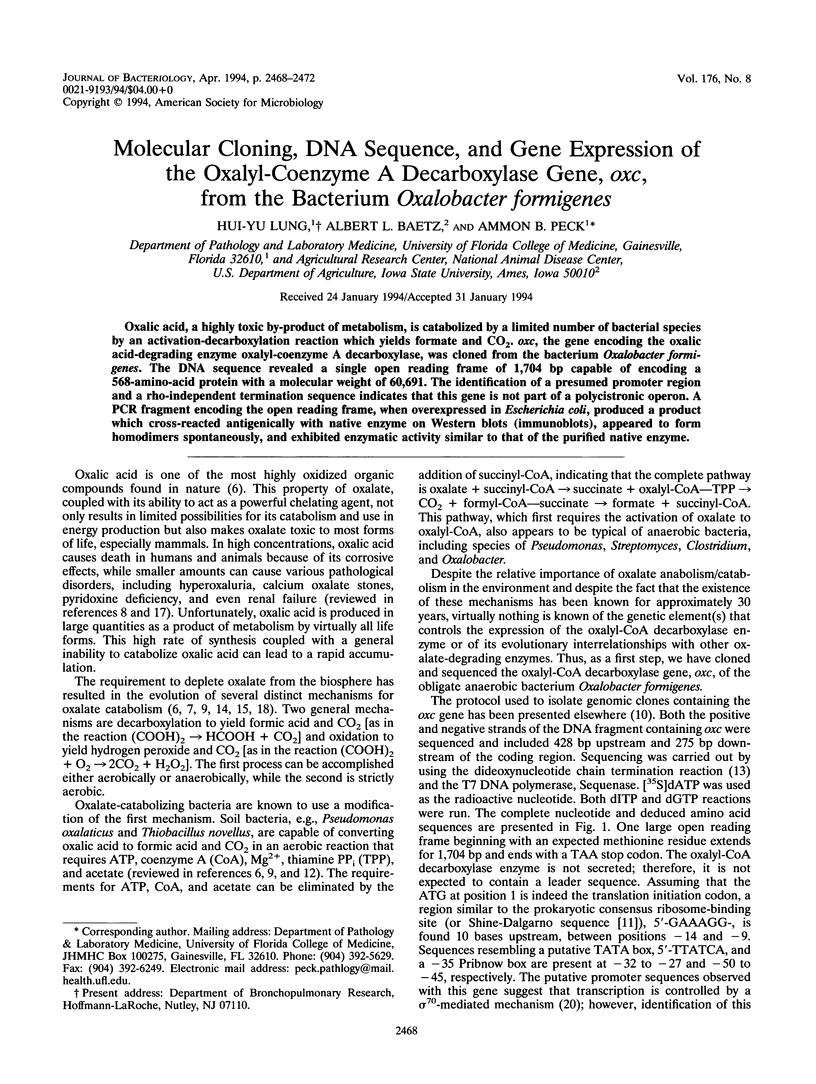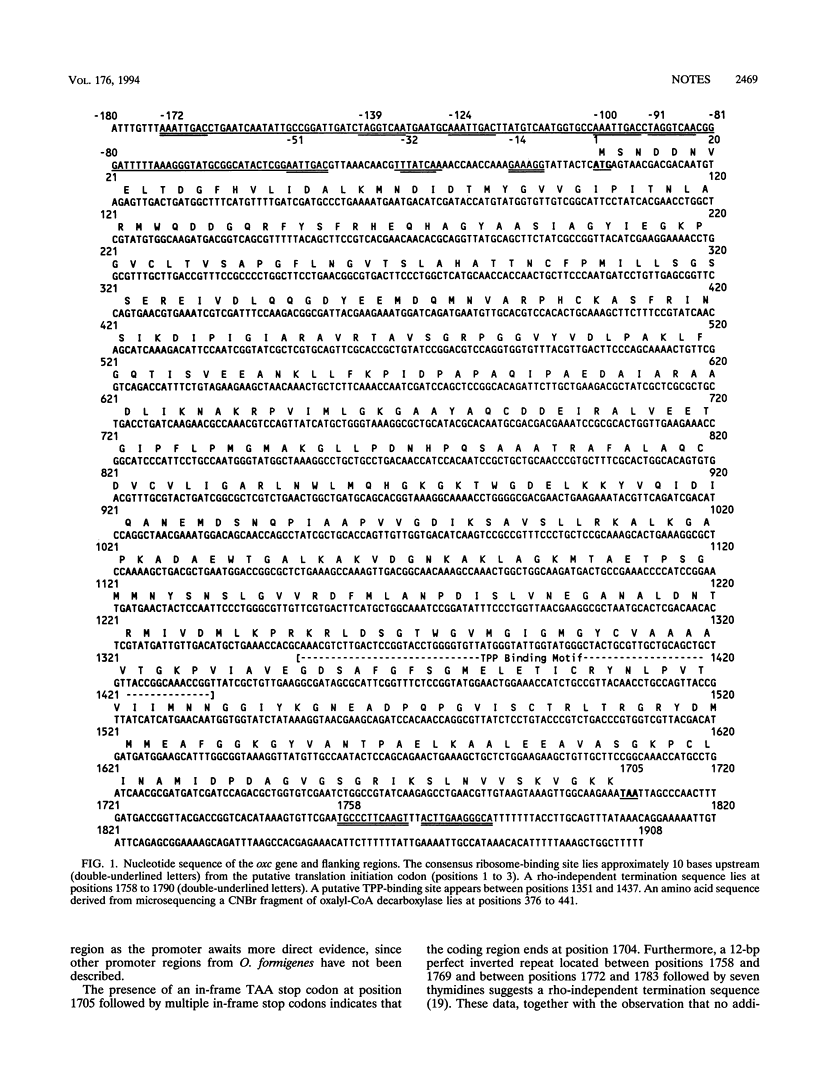Abstract
Oxalic acid, a highly toxic by-product of metabolism, is catabolized by a limited number of bacterial species by an activation-decarboxylation reaction which yields formate and CO2. oxc, the gene encoding the oxalic acid-degrading enzyme oxalyl-coenzyme A decarboxylase, was cloned from the bacterium Oxalobacter formigenes. The DNA sequence revealed a single open reading frame of 1,704 bp capable of encoding a 568-amino-acid protein with a molecular weight of 60,691. The identification of a presumed promoter region and a rho-independent termination sequence indicates that this gene is not part of a polycistronic operon. A PCR fragment encoding the open reading frame, when overexpressed in Escherichia coli, produced a product which cross-reacted antigenically with native enzyme on Western blots (immunoblots), appeared to form homodimers spontaneously, and exhibited enzymatic activity similar to that of the purified native enzyme.
Full text
PDF




Images in this article
Selected References
These references are in PubMed. This may not be the complete list of references from this article.
- Allison M. J., Dawson K. A., Mayberry W. R., Foss J. G. Oxalobacter formigenes gen. nov., sp. nov.: oxalate-degrading anaerobes that inhabit the gastrointestinal tract. Arch Microbiol. 1985 Feb;141(1):1–7. doi: 10.1007/BF00446731. [DOI] [PubMed] [Google Scholar]
- Anantharam V., Allison M. J., Maloney P. C. Oxalate:formate exchange. The basis for energy coupling in Oxalobacter. J Biol Chem. 1989 May 5;264(13):7244–7250. [PubMed] [Google Scholar]
- Baetz A. L., Allison M. J. Purification and characterization of formyl-coenzyme A transferase from Oxalobacter formigenes. J Bacteriol. 1990 Jul;172(7):3537–3540. doi: 10.1128/jb.172.7.3537-3540.1990. [DOI] [PMC free article] [PubMed] [Google Scholar]
- Baetz A. L., Allison M. J. Purification and characterization of oxalyl-coenzyme A decarboxylase from Oxalobacter formigenes. J Bacteriol. 1989 May;171(5):2605–2608. doi: 10.1128/jb.171.5.2605-2608.1989. [DOI] [PMC free article] [PubMed] [Google Scholar]
- Hawkins C. F., Borges A., Perham R. N. A common structural motif in thiamin pyrophosphate-binding enzymes. FEBS Lett. 1989 Sep 11;255(1):77–82. doi: 10.1016/0014-5793(89)81064-6. [DOI] [PubMed] [Google Scholar]
- JAKOBY W. B., BHAT J. V. Microbial metabolism of oxalic acid. Bacteriol Rev. 1958 Jun;22(2):75–80. doi: 10.1128/br.22.2.75-80.1958. [DOI] [PMC free article] [PubMed] [Google Scholar]
- James L. F. Oxalate toxicosis. Clin Toxicol. 1972;5(2):231–243. doi: 10.3109/15563657208991002. [DOI] [PubMed] [Google Scholar]
- KORNBERG H. L., ELSDEN S. R. The metabolism of 2-carbon compounds by microorganisms. Adv Enzymol Relat Subj Biochem. 1961;23:401–470. doi: 10.1002/9780470122686.ch8. [DOI] [PubMed] [Google Scholar]
- Lung H. Y., Cornelius J. G., Peck A. B. Cloning and expression of the oxalyl-CoA decarboxylase gene from the bacterium, Oxalobacter formigenes: prospects for gene therapy to control Ca-oxalate kidney stone formation. Am J Kidney Dis. 1991 Apr;17(4):381–385. doi: 10.1016/s0272-6386(12)80627-5. [DOI] [PubMed] [Google Scholar]
- Quayle J. R., Keech D. B., Taylor G. A. Carbon assimilation by Pseudomonas oxalaticus (OXI). 4. Metabolism of oxalate in cell-free extracts of the organism grown on oxalate. Biochem J. 1961 Feb;78(2):225–236. doi: 10.1042/bj0780225. [DOI] [PMC free article] [PubMed] [Google Scholar]
- SHIMAZONO H., HAYAISHI O. Enzymatic decarboxylation of oxalic acid. J Biol Chem. 1957 Jul;227(1):151–159. [PubMed] [Google Scholar]
- Sanger F., Nicklen S., Coulson A. R. DNA sequencing with chain-terminating inhibitors. Proc Natl Acad Sci U S A. 1977 Dec;74(12):5463–5467. doi: 10.1073/pnas.74.12.5463. [DOI] [PMC free article] [PubMed] [Google Scholar]
- Varshavsky A. The N-end rule. Cell. 1992 May 29;69(5):725–735. doi: 10.1016/0092-8674(92)90285-k. [DOI] [PubMed] [Google Scholar]
- Williams H. E., Smith L. H., Jr Disorders of oxalate metabolism. Am J Med. 1968 Nov;45(5):715–735. doi: 10.1016/0002-9343(68)90207-6. [DOI] [PubMed] [Google Scholar]
- Wyman H., Palmer J. K. Organic Acids in the Ripening Banana Fruit. Plant Physiol. 1964 Jul;39(4):630–633. doi: 10.1104/pp.39.4.630. [DOI] [PMC free article] [PubMed] [Google Scholar]
- Yanofsky C. Attenuation in the control of expression of bacterial operons. Nature. 1981 Feb 26;289(5800):751–758. doi: 10.1038/289751a0. [DOI] [PubMed] [Google Scholar]
- Youderian P., Bouvier S., Susskind M. M. Sequence determinants of promoter activity. Cell. 1982 Oct;30(3):843–853. doi: 10.1016/0092-8674(82)90289-6. [DOI] [PubMed] [Google Scholar]




